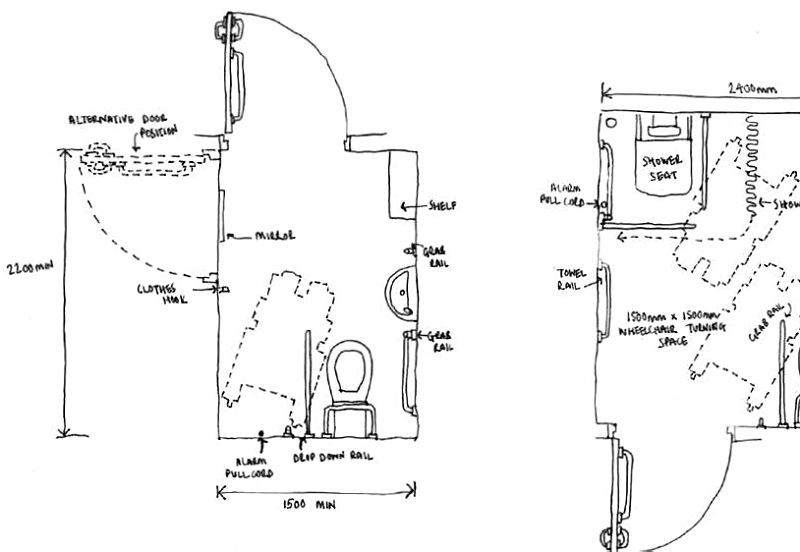Special educational needs: an analysis of the necessities for inclusion

|
| This article was written by Simone Gray, City College Plymouth. It was ‘highly commended’ in CIAT’s 2018 AT Awards in the category Student Award for Excellence in Architectural Technology (Report). The article first appeared in CIAT’s Autumn 2018 AT Journal. |
Contents |
[edit] Introduction
Simone Gray writes: “One of the modules I had to undertake as part of my foundation degree in Construction was ‘Research Project’. For this I had to write a mini dissertation: the decision to look at SEN facilities in schools came after seeing the struggles my parents went through trying to find a suitable school for my younger brother who has been diagnosed with autism. The limited number of schools with special education needs places in Plymouth made me question why all schools, especially new ones being built, were not to a standard that would be acceptable for students such as my brother.”
[edit] Designing for children with special educational needs
The report itself is a study of the main elements that need to be incorporated into a mainstream school that are necessary for the inclusion of children with special educational needs. To find out what those main features were and to determine end-user requirements, a study was undertaken by carrying out questionnaires of different teaching professionals along with semi-structured interviews of two schools in Plymouth.
Once the highest impacting elements were discovered, they were critically analysed and the report finishes with suggested guidelines for how to create a mainstream school that would be inclusive to all students.
The features that were investigated further included: classroom layout and acoustics, facilities such as hygiene and learning resource areas, and outdoor space.
It was concluded that the layout of a classroom is important due to the impact it has on how a child feels, functions and learns within that environment. There is a need for classrooms to be large enough to ensure accessibility to all students, and the use of zoned areas to break-up space to ensure ease of use and understanding of activities for the end user. Conclusions were drawn from the results of the questionnaires and interviews along with constant reference to government-approved guidelines to ensure that any recommendations would be compliant. Illustrations were used within the report to give examples of different design proposals and examples of feedback received, such as visual timetables.
The acoustics of a classroom were analysed with both technical and aesthetic aspects in mind. Published guidelines were used to determine the correct indoor ambient noise level and reverberation times of an ‘ideal’ classroom. These levels are important in a learning environment to ensure clear speech intelligibility and an ambient noise level that suites the end user. SEN pupils are more sensitive to sound and therefore require shorter reverberation times, and lower indoor ambient noise levels. Reverberation times can be controlled with the use of acoustic absorption materials.
These materials are graded A to E, with ‘A’ being highly absorbent and ‘E’ almost fully reflective. The absorbent materials can come in different forms including ceiling tiles, acoustic beams/ceiling panels, wall panels, and perforated/slatted wooden ceiling strips. Acoustic panels can also be used for aesthetic purposes as they can be produced in a wide range of colours, shapes, sizes or patterns. However, depending on the end use, this may cause too much of a distraction but this can be decided at the design stage.
When analysing facilities, care was taken to consider the recommendations received from the teaching professionals who undertook the questionnaire, including clear labelling, easy access and the need for space and discretion when required. However, most conclusions for hygiene and toilet facilities came from information published within government guidelines, including BB104 and Approved Document M to ensure that all design proposals were compliant.
[edit] Outdoor space
Outdoor space was the final area that was reviewed, with studies identifying benefits that can help develop and grow children with SEN. Having the ability to take a classroom outside, for exploration and learning can be sensory inspiring, especially when combining natural stimulators like wind, grass and trees with play equipment. A multi-sensory environment can promote interaction, communication, overcome boredom, reduce stress and relieve excess energy that a lot of SEN children have. Sandpits, musical instruments, play equipment and planting beds combined can create a natural, sensory outdoor space for teaching and play.
Along with these design considerations, children need a small transition area between leaving the classroom and entering outdoor space. Many children with SEN struggle with change and making the transition a smoother, simpler process will reduce stress and anxiety for the child. Having a covered outside space also means children can still attend outdoor classes when the weather is not good.
If all of these design elements were incorporated into compulsory guidelines when designing a mainstream school, more children with autism and other additional needs would not feel isolated and would receive the education they deserve and need. Social interaction, communication and relationships could be improved, meaning that the school life of 1,244,255 pupils could be improved.
[edit] Judge’s comments
This research focused upon inclusivity and wellbeing linked to special-need facilities and the design of spaces for people who would benefit from such an environment. An interesting subject area – academic and well researched with good context and clear aims and objective. A very relevant topic with thorough analysis, well presented and clearly illustrated. The section on acoustics is the most developed and technically relevant section.
This article was written by Simone Gray, City College Plymouth. It was ‘highly commended’ in CIAT’s 2018 AT Awards in the category Student Award for Excellence in Architectural Technology (Report). The article first appeared in CIAT’s Autumn 2018 AT Journal.
[edit] Related articles on Designing Buildings Wiki
- Access and inclusion in the built environment: policy and guidance
- Accessible London: Achieving an Inclusive Environment SPG
- Baseline designs for schools
- BREEAM Visual comfort View out
- Building Bulletin 93: acoustic design of schools.
- Building regulations
- Inclusive design
- Inclusive Environments, Built Environment Industry Action Plan
- People with disabilities definition
--CIAT
Featured articles and news
RTPI leader to become new CIOB Chief Executive Officer
Dr Victoria Hills MRTPI, FICE to take over after Caroline Gumble’s departure.
Social and affordable housing, a long term plan for delivery
The “Delivering a Decade of Renewal for Social and Affordable Housing” strategy sets out future path.
A change to adoptive architecture
Effects of global weather warming on architectural detailing, material choice and human interaction.
The proposed publicly owned and backed subsidiary of Homes England, to facilitate new homes.
How big is the problem and what can we do to mitigate the effects?
Overheating guidance and tools for building designers
A number of cool guides to help with the heat.
The UK's Modern Industrial Strategy: A 10 year plan
Previous consultation criticism, current key elements and general support with some persisting reservations.
Building Safety Regulator reforms
New roles, new staff and a new fast track service pave the way for a single construction regulator.
Architectural Technologist CPDs and Communications
CIAT CPD… and how you can do it!
Cooling centres and cool spaces
Managing extreme heat in cities by directing the public to places for heat stress relief and water sources.
Winter gardens: A brief history and warm variations
Extending the season with glass in different forms and terms.
Restoring Great Yarmouth's Winter Gardens
Transforming one of the least sustainable constructions imaginable.
Construction Skills Mission Board launch sector drive
Newly formed government and industry collaboration set strategy for recruiting an additional 100,000 construction workers a year.
New Architects Code comes into effect in September 2025
ARB Architects Code of Conduct and Practice available with ongoing consultation regarding guidance.
Welsh Skills Body (Medr) launches ambitious plan
The new skills body brings together funding and regulation of tertiary education and research for the devolved nation.
Paul Gandy FCIOB announced as next CIOB President
Former Tilbury Douglas CEO takes helm.
UK Infrastructure: A 10 Year Strategy. In brief with reactions
With the National Infrastructure and Service Transformation Authority (NISTA).























